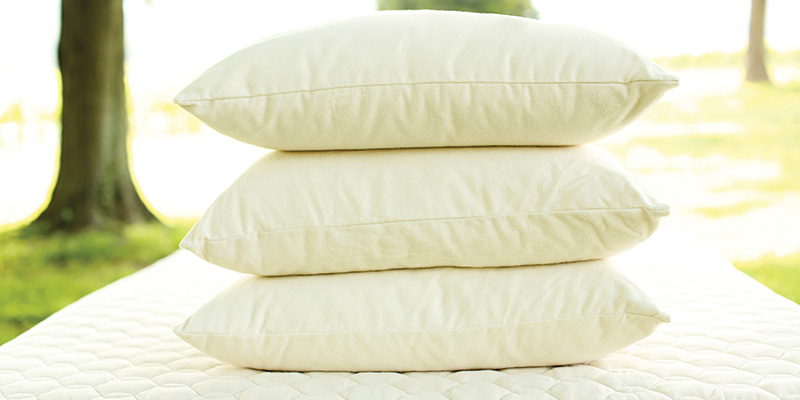Do you currently sleep on your stomach and want to switch to your back?
Back and side sleeping are much healthier sleep positions for several reasons.
This blog post focuses on the benefits of back sleeping, but also touches upon any potential downsides that you should be aware of when deciding what is best for your body.
Is it Better to Sleep on your Back?
It is not necessarily “better” to sleep on your back since everyone has their own factors that determine which sleep position is most comfortable and supportive for them. However, there are certainly benefits to sleeping on your back, one of the most known one being support for your spine. We dive into all the benefits below.
Keeps Neck & Spine Aligned
One of the greatest benefits of sleeping on your back is that it promotes proper neck and spinal alignment. As you sleep, you’re keeping your back straight whereas stomach sleepers have a greater chance of bending the back and suffering from lower back pain. Side sleepers may end up twisting and leaning forward too much (though a body pillow can solve this problem).
Fewer Wrinkles
When you sleep on your side or stomach, your face is coming into direct contact with your pillow, pressing down on your delicate skin. This can cause wrinkles and temporary inflammation. Sleeping on your back eliminates this problem.
If you prefer sleeping on your side, make sure you wash your pillowcases regularly to avoid bacterial build-up, which can cause acne breakouts.
Decreases Acid Reflux Symptoms
If you suffer from acid reflux, heartburn, or other issues related to digestion, it’s best to either sleep on your left side or propped up on your back. A wedge pillow may be helpful since it offers extra elevation. You may also want to consider an adjustable bed frame.

The Downsides
There is no perfect way to sleep. Here are a few potential downsides of sleeping on your back.
Snoring & Sleep Apnea
If you snore, you may want to avoid sleeping on your back.
WebMD notes that sleeping on your back causes the base of your tongue and soft palate to collapse to the back wall of your throat. Also, the weight of your neck can impact the airway, leading to snoring. Sleeping on your side can help mitigate this issue but if you’re snoring regardless of which sleep position you try, you should see a doctor. You may suffer from obstructive sleep apnea.
Not Recommended While Pregnant
Sleeping on your back is not recommended during pregnancy, both in terms of comfort and health.
When sleeping on your back in the second and third trimester, the weight of your uterus (and your baby) is pushing on your back and intestines. Sleeping on your back while pregnant can also affect blood circulation and digestion.
It is best to sleep on your left side while pregnant.
Why is Sleeping on my Back Uncomfortable?
There can be a whole list of reasons for this, but first you need to figure out if your mattress is too soft and/or failing. When a mattress is too soft or it begins to dip, it will cause you to sink into the mattress. Your spine will no longer be properly supported, leading to back pain. Also, keep in mind that even adding a firm mattress topper won’t solve the problem if your mattress has a dip. The topper will simply sink as well.
If you already deal with lower back pain, sleeping on your back may just be uncomfortable for you. Try sleeping on your side with a body pillow. The body pillow will help stop you from unintentionally moving around during the night. We recommend this shredded latex body pillow that is on the heavier side and will stay put.
However, it is also worth noting that some people simply just don’t like sleeping in certain positions due to specific comfort preferences that cannot be summarized easily. If your body is telling you something is uncomfortable, listen to it!

Pillow Needs for Back Sleepers
You want a pillow that will adequately support the neck. Typically, an overall medium-firm feel works best for back sleepers. A pillow that is too soft can negatively impact spinal alignment.
Best Savvy Rest Pillows for Back Sleepers
The most popular pillows we carry are our customizable ones since you can completely control the height and overall feel of the pillow. This unique feature allows you to adjust the pillow to your liking.
For back sleepers specifically, we recommend the wool or wool-latex blend pillows for sturdy support with a touch of softness. These are also fantastic options for those who “sleep hot” since wool is a natural temperature regulator.
Our soap-shaped pillow is also a popular choice for both back and side sleepers. This is a great option for those who enjoy the feel of latex. This particular pillow is made of Soft Dunlop latex but has an overall medium level of firmness.
The soap-shaped pillow has a relatively low-profile with a total thickness of about four inches. Since it is a formed latex pillow, this item is not customizable.
Still Have Questions?
We recommend checking out this mattress firmness guide if you are ready to shop for a new mattress but want to make sure you have proper support while sleeping on your back.
We are also happy to answer your questions over the phone! Call us at 866-856-4044 or you can email info@savvyrest.com.
